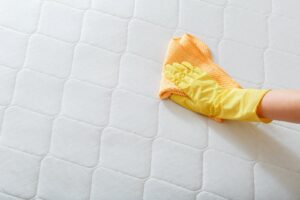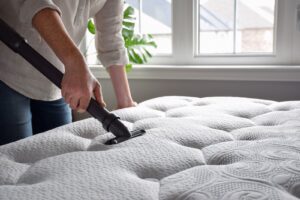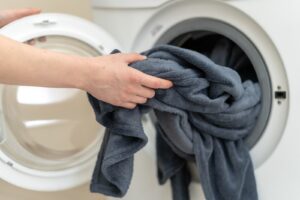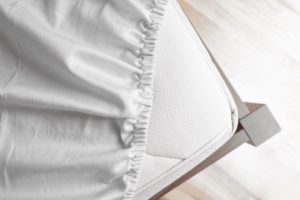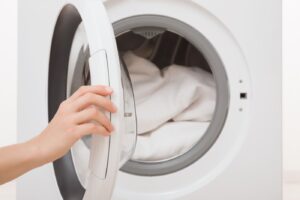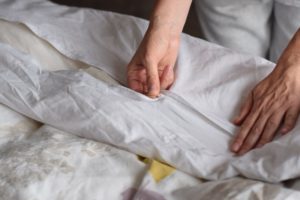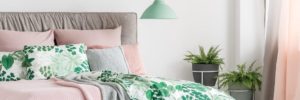Mattress Pad vs. Mattress Protector
- Although similar in appearance, a mattress pad and mattress protector have different purposes. A mattress pad is primarily designed to add an extra layer of cushioning. A mattress protector acts as a defensive barrier that can help prevent spills and allergens from damaging a mattress. While a mattress pad can change the overall feel of a bed, a mattress protector does not.
Mattresses can undergo a lot of wear and tear from daily use. They can also be susceptible to accidents, dirt, stains, and allergens. There are a variety of ways to protect your mattress and help ensure its longevity, and each comes with its own pros and cons.
Mattress pads and mattress protectors are often used in this capacity, but they are actually quite different in terms of purpose and performance. This is due in large part to their respective constructions and fill materials.
We’ll discuss both mattress pads and mattress protectors, explaining the differences and how to decide which one best fits your needs.
What Is a Mattress Pad?
A mattress pad is a thin, cushioned layer that is placed over a mattress like a fitted sheet. It acts as a protective barrier between you and your mattress while also making the mattress feel slightly more plush. Mattress pads typically consist of a quilted, pillowy surface that is 1 to 2 inches thick, along with a waterproof top layer. Their overall feel depends on the construction and fill, which can be natural or synthetic.
Although they are soft, mattress pads don’t significantly alter the firmness of a mattress.
Mattress Pad Types
Mattress pads are made with a variety of materials, such as cotton, wool, and polyester. Each has its own distinct look and feel.
| Natural Materials | Look & Feel |
|---|---|
| Cotton | A cotton-filled mattress pad is soft, breathable, and durable, even after repeated washing. It’s suitable for hot sleepers and is easier to maintain than wool or down. |
| Wool | Wool is soft, hypoallergenic, and naturally flame resistant. It also wicks away moisture and sweat. However, it may need special care when washed to prevent lumps from forming. |
| Down and Feather | A feather mattress pad has a soft, plush feel that works well on an extra firm mattress. The feathers’ light and airy texture stays relatively cool. However, it needs regular fluffing to ensure even distribution and prevent lumps. |
| Synthetic Materials | Look & Feel |
|---|---|
| Polyester | Polyester fibers make for a fluffy, hypoallergenic mattress pad that is affordable and easy to clean. This kind of mattress pad has a plush feel and a somewhat breathable surface. Polyester is sometimes blended with cotton for additional comfort. |
| Rayon | A rayon mattress pad is light, breathable, and won’t stick to the body. It feels plush and soft without any bulkiness. |
What Is a Mattress Protector?
A mattress protector is a thin, breathable barrier that shields the top of your mattress from harmful substances such as moisture, dirt, and stains. It’s constructed with an elastic edge similar to a fitted sheet and has no additional layer of padding on top. As a result, it doesn’t noticeably change or enhance the feel of your bed. However, they can be helpful in terms of extending the life of your mattress.
Mattress protectors can be waterproof or non-waterproof. Their lightweight design also makes them easy to clean.
Are All Mattress Protectors Waterproof?
Not all mattress protectors are waterproof, although most are. Waterproof mattress protectors usually contain a thin polyurethane layer that prevents spills, accidents, and sweat from being absorbed into the mattress. Non-waterproof protectors consist of a quilted water-resistant material such as a polyester and cotton blend.
Since plastic traps body heat, many waterproof mattress protectors incorporate breathable materials like cotton or bamboo-derived rayon for better temperature regulation.
Do Mattress Protectors Guard Against Dust Mites or Bed Bugs?
Standard mattress protectors don’t effectively guard against dust mites or bed bugs because they leave the sides and bottom of the mattress exposed. The best option for protecting your mattress against bed bugs and dust mites is a bed bug mattress cover, or mattress encasement. These are designed to protect the entire mattress rather than just the top.
Mattress Pad vs. Mattress Protector: Which Is Best for Your Needs?
Your lifestyle, needs, and preferences will determine if a mattress pad or mattress protector is best for you.
A mattress pad provides an extra layer of cushioning on top of your sleep surface and also acts as a protective barrier, especially if it has a waterproof layer.
However, if comfort isn’t a concern, a mattress protector may be your best option. It’s designed to be unnoticeable while sleeping and often contains a waterproof surface that prevents damaging fluids and allergens from affecting the mattress.
| You’ll Want a Mattress Pad If: | You’ll Want a Mattress Protector If: |
|---|---|
|
|

Still have questions? Ask our community!
Join our Sleep Care Community — a trusted hub of sleep health professionals, product specialists, and people just like you. Whether you need expert sleep advice for your insomnia or you’re searching for the perfect mattress, we’ve got you covered. Get personalized guidance from the experts who know sleep best.

